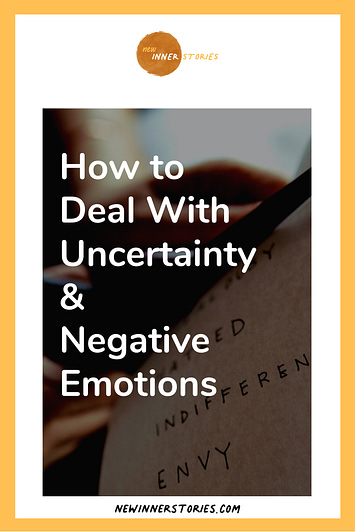The Merriam-Webster dictionary defines uncertainty as “the state of being uncertain”. But this is not enough of a description, because we experience this state of being uncertain all the time about the weather, about our lives, and about the world, without necessarily feeling uncertain.

So when we talk about uncertainty, the one that we actually feel, we’re talking about a conscious experience of ignorance.
It’s when you are aware that you don’t know about something that you would rather know.
And why is this a feeling that we suffer from? Because people tend to simulate negative outcomes of situations. And this is what links uncertainty to negative emotions, stress, and anxiety.
Let’s look into this.
Uncertainty can come from:
We basically want to know about what’s in front of us. But do we always?
If you’re told that you’ll be given a painting for your birthday in 2 weeks, how happy will you be about having that information? And if you’re told that your team is going to win (or lose) at the end of a match, would you still watch it with the same excitement?
Sometimes we want to keep things uncertain because that’s what makes them fun!
So why can we have the same approach when it comes to life’s outcomes and tend to worry, and stress, and get anxious?
Let’s look into emotions for a second.
Why do we have emotions?
There are many theories, but basically they’re a reaction to the environment that gives a signal to you to wether keep or change your attention and whether to keep or change your situation. And, of course, this evaluation would be linked to your needs, desires, and expectations.
So the perceived certainty of a situation, will lead to different emotions.
If you’re certain that something negative will happen, you’ll experience sadness. And if you’re uncertain that something positive will happen, you might experience feelings of hope, or anticipated joy.
And this is why different people can experience a wide range of emotions to the exact same situation.
Let’s say you lost your job. You can take the uncertainty of the future as an opening for new opportunities, learnings, people and experiences, or you can see the same situation as a great loss, a very negative experience with negative consequences.
So a key factor for why uncertainty brings negative emotions is mental simulation
It’s what you play in your mind about a situation and the potential results of it in the future that influences how you feel. The good news is, you can have control over your emotions and you can transform them into more positive and constructive states of feeling and being.
How can you regulate your emotions?
Choose your environment
Even before you experience a situation, you can actually determine (some of the) situations you’re in. For example, you can decide whether you’ll watch a comedy or a horror movie. You can determine if you want to watch the news 2 hours a day or 20 minutes. You can determine if you want to follow 1000 instagram accounts that make you anxious about your life, or follow 100 that inspire you to live your best life.
Adjust your environment
Let’s say you went for the horror movie. If you’re feeling really scared during a scene, you can turn on the lights. Or if you want to watch the news, you can choose which channel feel most in line with how you want to feel about what’s happening in the world. The point here is that you don’t have to watch the situations roll out and be passive about them. You can always choose to do something that can potentially help you feel better.
Control your openness
You might close your eyes during that scary scene, as much as you can control which conversation you engage in, or how many depressing videos you share or click on while scrolling through your Facebook feed.
Rethink the situation
You can remind yourself that what you’re watching is not real life but just a movie. In the same way as you can look at things as failures or opportunities. It’s about realising that you have the power to choose what to tell yourself about the situation. If you find yourself simulating negative outcomes, can you visualise other, more positive, outcomes that can also turn out to be true?
Introduce a different emotion
You can very well put yourself in another mood only by consciously making an effort to do so. And you can do this easily by just changing your posture, producing a smile, or taking some deep breaths. As well as by reminding you of all the possible positive outcomes a situation can give you.
POWER
The key factor here is POWER. You have the power to change your emotions in any given situation. It might take a conscious effort but it’s doable. And worth giving a try for the rewards of living happier.
Practice Radical Acceptance
Another think you can do to handle your negative emotions is Radical Acceptance. For that I have prepared a spreadsheet you can use to help you analyse your thoughts and emotions about a painful situation and reframe it to accept it.
If you’d like to have this one just sign up to my list so you’ll get access to that spreadsheet and all my other free resources.
That’s all for now, stay well, stay happy.

